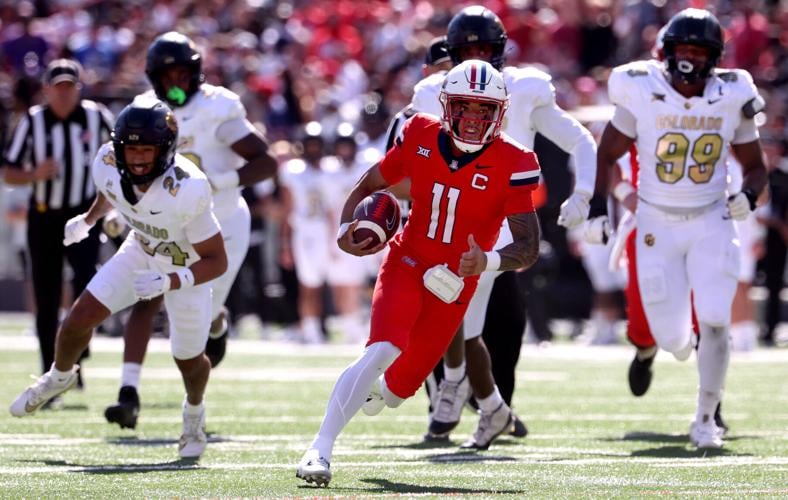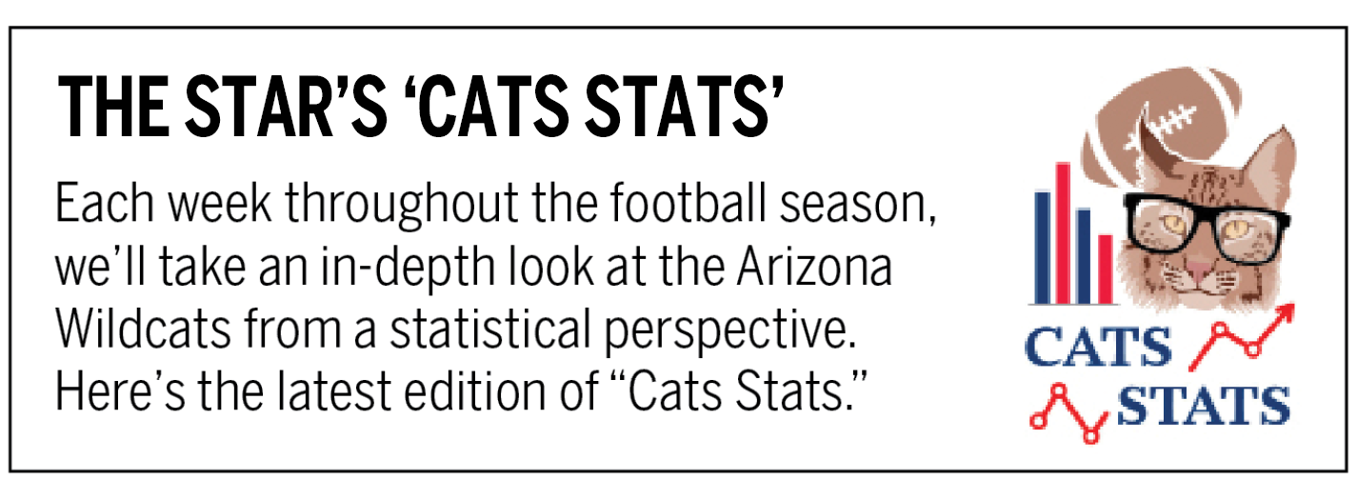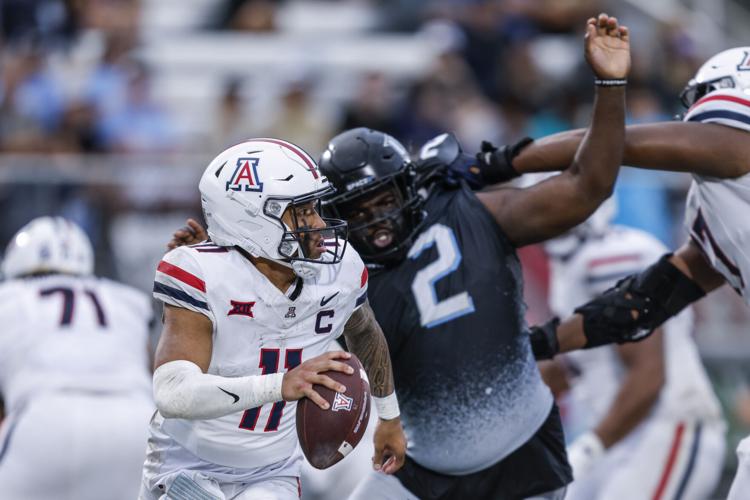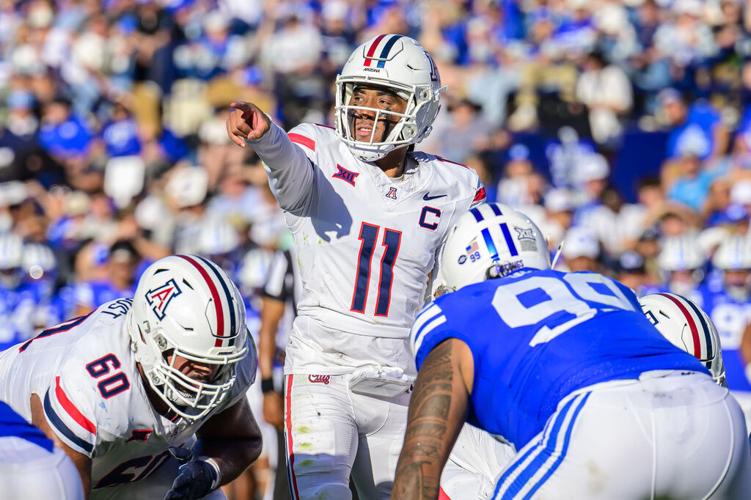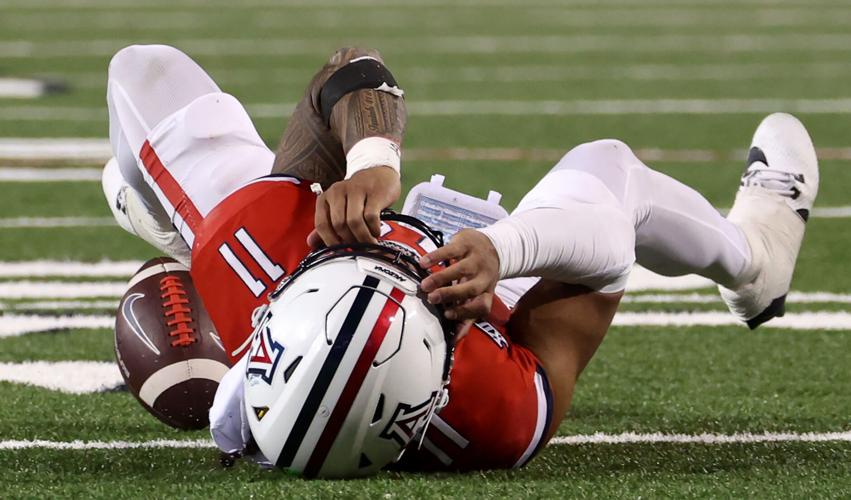Noah Fifita did not wake up the morning after the Alamo Bowl and become a worse quarterback. He did not become a shorter quarterback either.
OK, smart guy, then why are his numbers so much worse this year than last? And why has the Arizona offense fallen so short of expectations?

It’s easy to blame the quarterback, and Fifita has been willing to fall on the sword — the metaphorical one, not the defense’s Turnover Sword, thankfully — again and again. He hasn’t been as sharp overall. But really, he’s covering for others — a coaching staff that didn’t set him up for success, an offensive line that fell apart because of injuries and a diminished set of skill-position players.
We’ve reached the point in the 2024 season where Fifita has played almost the same amount of football as a year ago. In 2023, he took 370 dropbacks and attempted 333 passes; currently, those numbers are 363 and 322.
As such, it’s a useful time to examine Fifita’s performance from multiple angles to try to figure out what’s changed and why. That is our objective in this bye-week edition of “Cats Stats.”

Arizona quarterback Noah Fifita scampers into the Colorado backfield on a scramble into the red zone in the first quarter of their game Oct. 19, 2024, at Arizona Stadium.
Recent improvement
Let’s start with what’s gone on lately: Fifita has played better.
The redshirt sophomore has a 4-0 touchdown-to-interception ratio the past two weeks. In the previous six games — starting with NAU and ending with Colorado — Fifita’s ratio was 5-9.
Fifita easily could have thrown a pick against West Virginia on Oct. 26. But that was his only turnover-worthy play in that game, according to Pro Football Focus. He had none vs. UCF this past Saturday — his first such game since NAU. In the four-game stretch from Sept. 13-Oct. 12 — Kansas State through BYU — Fifita had 10 turnover-worthy plays.
Fifita’s completion percentage also has ticked up. He has hit on 69.2% of his passes the past two weeks. In the previous five games, that figure was 57.5%.
What has fueled that improvement? Two numbers jump out. One is Fifita’s completion percentage on passes thrown 20-plus yards downfield. He’s hit on 66.7% of those (6 of 9) the past two weeks, per PFF. In the first seven games, his success rate was just 28.2%.

Arizona quarterback Noah Fifita, left, scrambles away from UCF defensive tackle Lee Hunter during the second half of the Knights' win over the visiting Wildcats Nov. 2, 2024, in Orlando, Florida.
Fifita also has handled pressure better. He has completed 65% of his passes with one touchdown and zero interceptions when pressured the past two weeks, per PFF. In the first seven games, his completion rate under pressure was 40.2% with a 2-5 TD-INT ratio.
Fifita hasn’t faced any less pass-rush pressure the past two games; he’s actually dealt with more. West Virginia and UCF combined for a 40% pressure rate, per PFF. That figure over the first seven games was 36.8%.
Lingering problems
Fifita is still holding onto the ball too long.
His average time to throw (TTT) is 3.24 seconds. That’s the highest figure in the nation, per PFF (minimum 215 dropbacks). It hasn’t been any better the past two weeks (3.37 vs. West Virginia, 3.21 vs. UCF).
Last season, Fifita’s average TTT was 2.55 seconds. That was tied for the 16th lowest nationally (minimum 312 dropbacks).
Fifita did not have a single game last season with a TTT of three seconds or more — and none were higher than 2.60 after the USC game (his second career start). This year, he has only one game under three seconds — the opener vs. New Mexico (2.69).
Why is this still an issue? It could be that Fifita, having been pressured so much, is almost preoccupied with the rush. (This is sometimes referred to as “seeing ghosts.”) It could be that the offensive structure and route concepts aren’t conducive to getting the ball out. It could be that Fifita is trying to make big plays instead of taking what the defense is giving. Or it could be that receivers aren’t getting open.
Fifita’s ADOT (average depth of target) of 9.0 yards is 1.2 yards higher than last year’s 7.8. It’s been 7.3 or lower in three of the past four games, so it appears some adjustments have been made.
Fifita hasn’t thrown as many short passes over the middle overall — about 31.4% of his attempts this year vs. 43.6% last year. He also hasn’t thrown as many screen passes (13.8% vs. 18.4%) or play-action passes (17.6% vs. 27.0%).
The latter could explain Fifita’s drop-off on passes thrown 10-19 yards downfield — the void behind linebackers drawn in by play-action fakes. Last year he hit on 67.8% of those with a 6-0 TD-INT ratio, per PFF. This year those numbers are 52.5% and 2-3.

Arizona quarterback Noah Fifita agonizes after dropping a pass with nobody between him and the end zone in the fourth quarter against West Virginia, Oct. 25, 2024, at Arizona Stadium.
Playing from behind
Arizona’s overall falloff this season has put Fifita in a difficult spot: He and the Wildcats have been playing from behind a lot more.
Per CFBStats.com, Fifita has attempted 215 passes when Arizona has been trailing this season. Last year he threw only 99 passes when the Wildcats were down.
Breaking it down further: Fifita has attempted 121 passes when Arizona has trailed by 15 or more points. Last year he threw only three in that scenario.
One could argue that it’s easier to pass when playing from behind because there isn’t as much pressure, literally or figuratively. But it also makes offenses one-dimensional.
Flipping it around, Fifita has attempted only 52 passes when Arizona has had the lead — vs. 165 last year. He was a 76.8% passer when operating from ahead in 2023.
Not that far off
Two more stats suggest Fifita isn’t that different a player than he was a year ago.

Arizona quarterback Noah Fifita, center, points out the defensive rusher at the line of scrimmage during the Oct. 12 game at BYU.
One is adjusted completion percentage, which PFF defines as the percentage of aimed passes thrown on target. Fifita’s adjusted completion percentage this year is 74.4% — just four percentage points lower than last year’s mark of 78.4%.
Why is there such a big disparity this year between Fifita’s adjusted completion percentage and his actual one (61.2%)? The biggest factor is that Fifita has thrown the ball away 33 times — most in the nation by 11. Last year he had only seven throwaways. That bloated number implies that Fifita isn’t seeing the field well, plays aren’t working or both.
The final stat worth noting is passes batted down at the line of scrimmage. Per PFF, Fifita had four such passes last year. This year he has ... the same amount.
Fifita, who’s listed at 5-foot-10, always will be height-challenged. He’s been able to overcome it at every stage of his career. He can do so again with the right support system.


